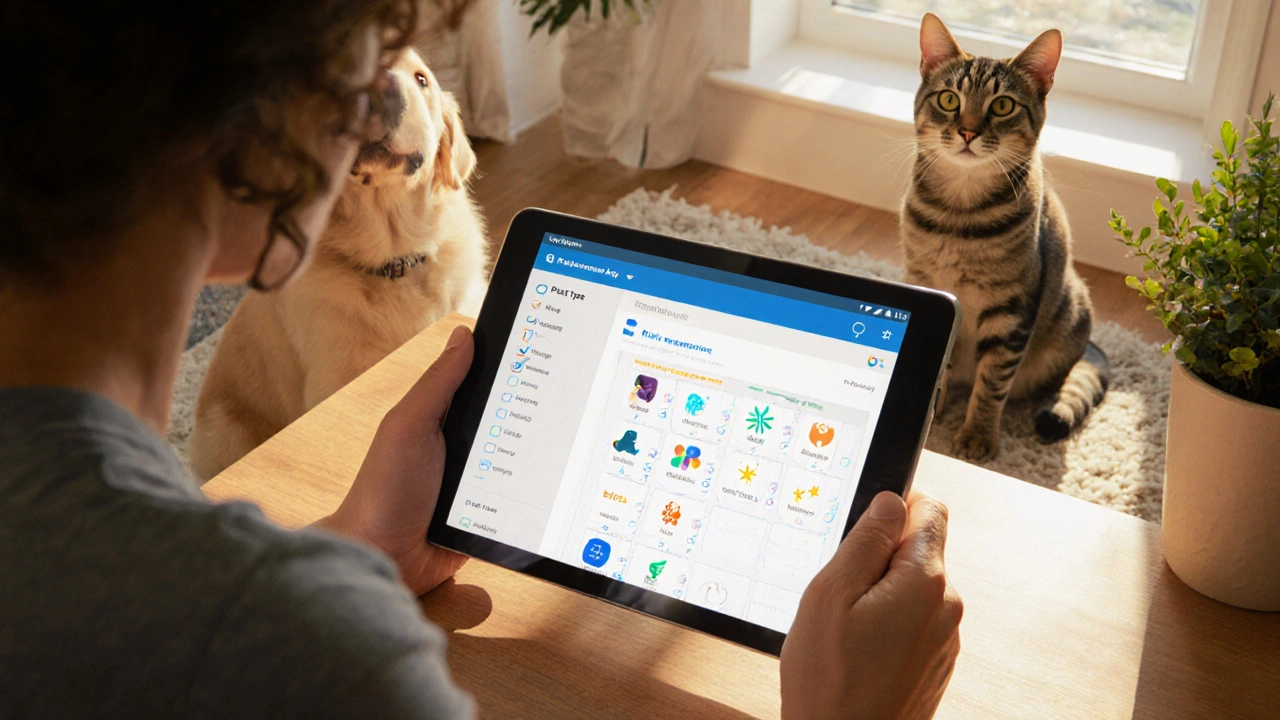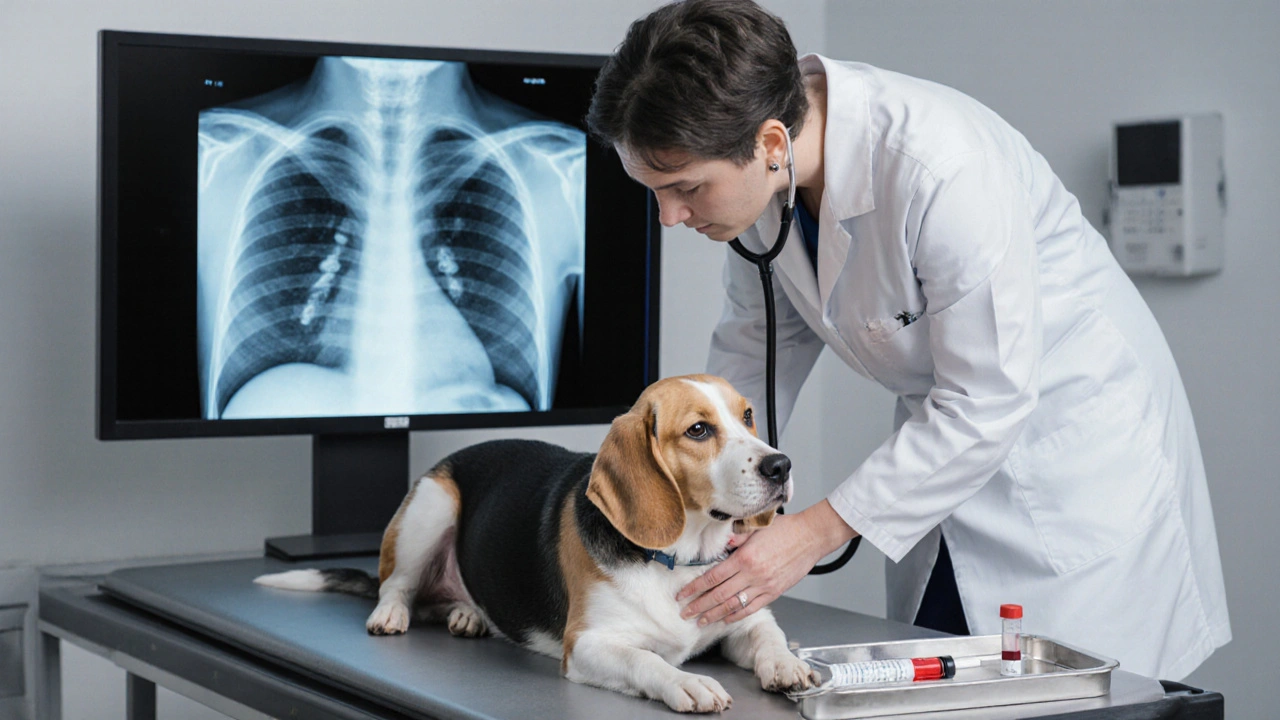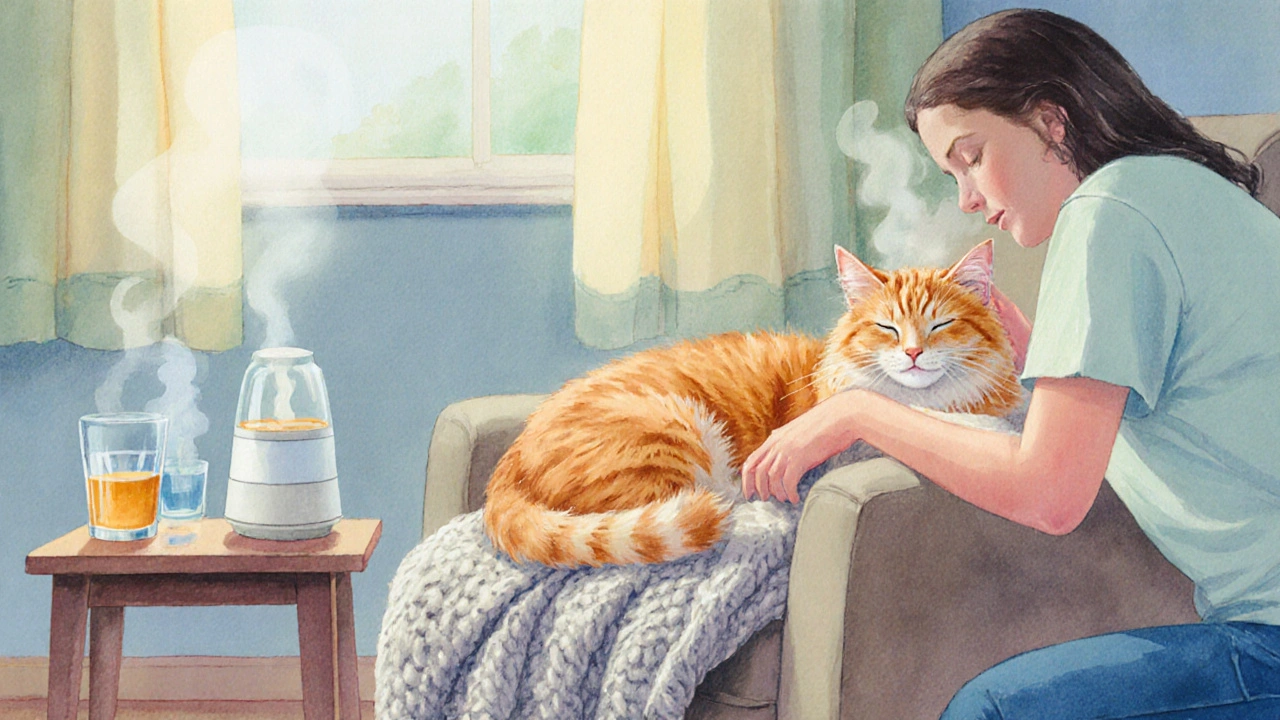Pet Pneumonia: Symptoms, Prevention & Treatment Guide
 Oct, 4 2025
Oct, 4 2025
Pet Pneumonia Risk Assessment Tool
Symptoms Present
Persistent Cough
Rapid Breathing
Fever
Lethargy
Loss of Appetite
Discolored Gums
Risk Factors
Environmental Factors
Risk Assessment Results
When a pet develops Pneumonia in pets is a serious lung infection that can affect dogs, cats, and even exotic animals, owners often feel helpless. This guide walks you through what to watch for, how to keep your companion safe, and what treatment looks like once a vet confirms the diagnosis.
Why pneumonia matters for dogs and cats
Veterinary hospitals in Australia report that pneumonia accounts for roughly 5% of emergency visits for dogs and 3% for cats each year. Small breeds such as Chihuahuas and kittens under six months are especially vulnerable because their immune systems are still developing. If left untreated, the infection can progress to sepsis, organ failure, or even death within days.
What causes pneumonia in pets
Understanding the root cause helps owners take proactive steps. The most common culprits are:
- Bacterial infections - Streptococcus and Bordetella bronchiseptica are frequent triggers after a kennel stay.
- Viral agents - Canine parainfluenza virus and feline calicivirus can damage airway lining, making bacterial invasion easier.
- Fungal spores - In humid climates, Aspergillus can cause chronic pneumonia, especially in older cats.
- Aspiration - Inhalation of food, vomit, or foreign objects often leads to inflammation and secondary infection.
Species‑specific risk factors
Not all pets face the same odds. Below are the most common risk factors for the two main companions.
- Dogs - Recent travel, exposure to other dogs, and crowded boarding facilities.
- Cats - Upper respiratory infections, indoor‑only lifestyle (which can hide symptoms), and pre‑existing heart disease.
- Other small mammals (rabbits, ferrets) - Often develop pneumonia after stressful moves or when kept in poorly ventilated cages.
Spotting the warning signs
Early detection makes a huge difference. The table below lists the most common clinical signs and how they may appear in dogs versus cats.
| Symptom | Dogs | Cats |
|---|---|---|
| Persistent cough | Dry, hacking cough; may be worse after exercise | Rare, but may produce a gagging sound |
| Rapid breathing | Visible chest lift, panting at rest | Shallow, quick breaths; often hidden by grooming |
| Fever | Temperature > 39.5°C (103.1°F) | Temperature > 39.2°C (102.5°F) |
| Lethargy | Reluctant to walk, sleeps more than usual | Hides, reduced play, less appetite |
| Loss of appetite | Refuses food for > 24 hrs | Skips meals, may vomit |
| Discolored gums | Pale or bluish gums indicating low oxygen | Blue‑tinged gums, especially around teeth |

How vets confirm pneumonia
Diagnosing the condition involves a combination of physical exam and diagnostic tools. Typical steps include:
- Listening to lung sounds - crackles or wheezes suggest fluid buildup.
- Chest X‑ray (radiography) - reveals infiltrates, consolidation, or fluid lines.
- Complete blood count (CBC) - looks for elevated white blood cells.
- Bronchoalveolar lavage (BAL) or tracheal wash - samples taken for bacterial culture and antibiotic sensitivity.
- Pulse oximetry - measures blood oxygen saturation; values below 92% often trigger supplemental oxygen.
Prevention: Keeping lungs healthy
While no method guarantees zero risk, the following practices dramatically cut the odds:
- Vaccination - Core vaccines protect against canine parainfluenza and feline calicivirus, both of which can precede pneumonia.
- Limit exposure to crowded dog parks or boarding kennels during peak cough season (spring-early summer).
- Maintain good indoor air quality - avoid smoking, use HEPA filters, and keep humidity between 40‑60%.
- Regular dental care - teeth infections can seed bacteria to the lungs.
- Prompt treatment of upper respiratory infections - early antivirals or antibiotics stop spread to lower airways.
Treatment options once pneumonia is diagnosed
Therapy usually blends medication with supportive care. The exact plan depends on the underlying cause and severity.
- Antibiotics - Broad‑spectrum drugs like amoxicillin‑clavulanate are first‑line for bacterial pneumonia. Culture results guide a switch to targeted therapy.
- Antifungals - For fungal cases, itraconazole or fluconazole are prescribed for 4‑8 weeks.
- Supportive oxygen - Nasal cannula or oxygen cage keeps blood oxygen above 95%.
- Corticosteroids - Low‑dose prednisolone can reduce inflammation when viral agents dominate, but they’re avoided if a bacterial infection is unchecked.
- Fluid therapy - Intravenous fluids maintain hydration and help thin mucus secretions.
- Bronchodilators - Nebulized saline or aerosolized meds open airways in severe wheezing.
Most dogs improve within 48‑72 hours of starting antibiotics, while cats may need a slightly longer course (10‑14 days) due to slower metabolic rates.
Home care tips while your pet recovers
After the vet’s discharge, continue these steps at home:
- Keep the environment warm and draft‑free; a temperature of 20‑22°C (68‑72°F) is ideal.
- Offer small, frequent meals - boiled chicken and rice are easy on a sore throat.
- Encourage gentle exercise - short leash walks for dogs and brief indoor play for cats promote lung expansion.
- Monitor cough and breathing - any worsening warrants a call to the clinic.
- Finish the full antibiotic course, even if the pet looks better.
When to seek emergency care
Even with treatment, some signs signal a life‑threatening situation:
- Rapid, shallow breathing or open‑mouth panting.
- Blue‑tinged gums or tongue.
- Severe lethargy - pet can’t lift its head.
- Vomiting repeatedly, preventing nutrient intake.
- Fever above 40°C (104°F) that doesn’t drop with medication.
In these cases, head straight to an emergency veterinary hospital. Early aggressive intervention can mean the difference between recovery and irreversible damage.

Frequently Asked Questions
Can a cat catch pneumonia from a dog?
Yes, especially if the dog is coughing and both animals share the same indoor air. The bacteria can jump between species, so isolating a sick pet and cleaning the environment helps prevent spread.
Is pneumonia in puppies treatable without hospitalization?
Mild cases can be managed at home with oral antibiotics, close monitoring, and supplemental oxygen via a portable concentrator. However, any sign of distress or worsening cough usually requires a brief hospital stay for IV fluids and intensive care.
How long does it take for a pet to fully recover?
Most dogs recover in 7‑10 days after completing antibiotics, while cats may need up to 2 weeks. Follow‑up X‑rays are recommended to ensure the lungs have cleared.
Are there natural remedies that help?
Honey (for dogs over one year) can soothe cough, and coconut oil may aid airway lubrication, but they should never replace prescribed antibiotics. Always discuss supplements with your vet first.
What’s the cost of treating pneumonia in Australia?
A basic outpatient case (exam, X‑ray, antibiotics) runs between AU$300‑$500. Hospitalization with oxygen and IV fluids can climb to AU$1,200‑$2,000, depending on length of stay.

Tiarna Mitchell-Heath
October 4, 2025 AT 18:35Listen up, anyone who thinks a cough is just a cough is living in denial – pneumonia kills pets faster than a bad haircut. You need to act on those rapid breaths and fever, not wait for a vet to roll in with a clipboard. Stop pretending you’re too busy, schedule an appointment now and keep your home ventilated like a hospital. If you’re still unsure, just remember that a dead pet is a permanent reminder of your procrastination. Get serious, get help, and stop treating your dog like a stray.
Katie Jenkins
October 5, 2025 AT 12:53Actually, the guide correctly notes that Streptococcus and Bordetella are the most common bacterial culprits, but it omits the fact that Mycoplasma can also be a hidden player in canine pneumonia. Moreover, the dosage guidelines for amoxicillin-clavulanate should be weight‑based, typically 20 mg/kg BID, which the article glosses over. The ventilation advice is solid, yet a HEPA filter with a CADR rating of at least 150 cfm would be optimal for a medium‑sized living area. Finally, the recovery timeline for cats often extends to 14‑21 days, not just 7‑10, due to slower metabolism. Please ensure future updates reflect these nuances for clarity.
Jack Marsh
October 6, 2025 AT 07:11While the information is thorough, I must point out that the emphasis on antibiotics may overlook the rising incidence of antimicrobial resistance, a concern not addressed here. It would be prudent to discuss culture‑guided therapy rather than blanket empirical treatment. Additionally, the article fails to mention that certain breeds, such as English Bulldogs, are predisposed to aspiration pneumonia due to brachycephalic anatomy. The omission of these breed‑specific risks could mislead owners seeking targeted preventive measures. In summary, a more balanced discussion of both pharmacologic and supportive strategies is warranted.
Terry Lim
October 7, 2025 AT 01:29People who ignore basic hygiene are simply irresponsible.
Cayla Orahood
October 7, 2025 AT 19:47Do you ever wonder why every time a puppy gets a cough, the whole neighborhood starts gossiping like there’s a pandemic? It’s as if the air itself conspires against our fluffy friends, weaving invisible toxins that settle in their tiny lungs. The guide mentions poor ventilation, but what it doesn’t scream about is the covert role of industrial smog drifting from nearby factories. Some say the government deliberately under‑reports respiratory illnesses in pets to keep the economy humming – a classic cover‑up. And don’t get me started on the hidden agenda of pet food companies pushing low‑quality proteins that weaken immunity. All this makes me think that the “preventive care” tips are just surface‑level Band‑Aid solutions for a deeper, systemic problem. Remember, every cough might be a symptom of a larger, orchestrated decay of animal health, not merely an isolated infection.
McKenna Baldock
October 8, 2025 AT 14:05It’s interesting to contemplate how environmental factors intersect with physiological vulnerability. If we regard the pet’s respiratory system as a window, then the quality of the surrounding air becomes a mirror reflecting broader ecological health. Maintaining proper humidity and eliminating indoor smoke not only benefits the animal but also aligns with a holistic view of stewardship. Moreover, regular veterinary check‑ups act as philosophical checkpoints, prompting us to reassess our responsibilities. In this way, caring for a pet transcends mere duty and becomes an ethical practice.
Roger Wing
October 9, 2025 AT 08:23First of all the article completely ignores the role of viral co‑infections in exacerbating bacterial pneumonia and this is a major oversight second the recommendation to use broad‑spectrum antibiotics as a first line treatment is outdated modern research shows that targeted therapy based on culture results reduces resistance rates significantly third the piece fails to address the potential for fungal pathogens such as Aspergillus especially in humid climates where spores thrive fourth the environmental factors listed are too generic one should install HEPA filtration and maintain indoor humidity between 40 and 60 percent to limit pathogen growth fifth the guide suggests a one‑size‑fits‑all timeline for recovery but cats often need longer courses of antibiotics up to two weeks and dogs may require supportive oxygen therapy beyond the initial 48 hour window sixth the mention of vaccination omits the importance of Bordetella and canine influenza vaccines for dogs and feline calicivirus and herpesvirus for cats seventh the advice on home care neglects the need for monitoring blood gas levels in severe cases to ensure adequate oxygenation eighth the article does not discuss the potential side effects of corticosteroids such as immunosuppression ninth the suggestion to keep the pet warm is good but it should be coupled with avoiding overheating which can worsen respiratory distress tenth the guide should emphasize the importance of follow‑up chest radiographs to confirm resolution eleventh the piece could benefit from a decision‑tree algorithm to help owners triage symptoms more effectively twelfth the statement about “no immediate action required unless symptoms worsen” is risky because pets can deteriorate rapidly without obvious external cues thirteenth the inclusion of a cost estimate is useful but should be adjusted for regional variations fourteen the recommendation to avoid smoking indoors is obvious but many owners underestimate the impact of third‑hand smoke on pet health fifteen overall the article provides a good foundation but needs significant expansion to address these critical gaps
Mike Brindisi
October 10, 2025 AT 02:41Look you all missed the point the guidelines should have a clear algorithm for when to start IV fluids the dosage is 10 ml/kg over 6 hours and you need to monitor electrolytes the article also forgot to mention that oxygen therapy should be titrated to keep SpO2 above 95% not just “give oxygen” the risk factors list is too short they need to add recent antibiotics use as a predisposing factor also the recommendation to keep the environment warm ignores that temperature spikes can cause heat stress in brachycephalic breeds you guys need to read the latest vet journal articles instead of posting half‑baked advice
Steven Waller
October 10, 2025 AT 20:59Hey folks, great discussion here! Let’s remember that while antibiotics are crucial, supportive care like gentle chest physiotherapy can really help clear mucus. Also, keeping a calm environment reduces stress, which in turn supports the immune system. If you notice any regression, don’t hesitate to get back to the vet for a re‑check. Together we can give our pets the best chance at a full recovery.
Puspendra Dubey
October 11, 2025 AT 15:17Yo im sooo shur someone thats not tellin u wut 2 do bout dis whole thing i mean its like an epic saga but also like dust in the air and the vet cant even like handle it properly u kno? they only give ur meds but no love
its drama
kevin muhekyi
October 12, 2025 AT 09:35I’ve seen a few cases where owners just keep their pets warm and feed them soft foods, and the animals bounce back without needing a hospital stay. It’s definitely worth trying at home if the symptoms are mild and you can monitor them closely.
Teknolgy .com
October 13, 2025 AT 03:53Feels like another generic vet article… 🤔🤷♂️
lalitha vadlamani
October 13, 2025 AT 22:11One must acknowledge that neglecting proper respiratory care in pets is tantamount to moral failure, especially when evidence abounds regarding preventable infections. The societal duty to protect vulnerable animals cannot be overstated; thus, any advice that downplays early intervention borders on irresponsible negligence. Scholars and practitioners alike should champion stringent standards, ensuring that each caregiver adheres to best practices without exception.
kirk lapan
October 14, 2025 AT 16:29Sure the guide is detailed but let’s be honest, it glosses over the nuanced pharmacokinetics of fluoroquinolones in felines (a 20‑30% difference in bioavailability). Also, the claim that “most dogs improve within 48‑72 hours” is overly optimistic-clinical data shows a median of 5 days for complete resolution. Finally, the recommendation to keep humidity at 40‑60% is technically correct, but many households lack the proper hygrometer to verify this statistic, rendering the advice practically useless without proper instrumentation.
Landmark Apostolic Church
October 15, 2025 AT 10:47It’s fascinating how pet health mirrors cultural attitudes toward animal welfare. In societies where animals are considered family, ventilation standards are higher and preventive vaccinations are routine. Conversely, in regions where pets are viewed merely as utility, pneumonia rates skyrocket due to neglect. Bridging this cultural gap could drastically reduce incidence worldwide.
Matthew Moss
October 16, 2025 AT 05:05From a national perspective, it is unacceptable that many owners disregard basic preventive measures, thereby endangering the health of our cherished companions. The responsibility to enforce strict guidelines lies with both government agencies and community leaders, ensuring no pet suffers due to ignorance or complacency.
Antonio Estrada
October 16, 2025 AT 23:23I appreciate the thoroughness of the guide and would add that sharing this information with fellow pet owners can foster a community of informed caregivers, ultimately leading to better outcomes for all our animals.